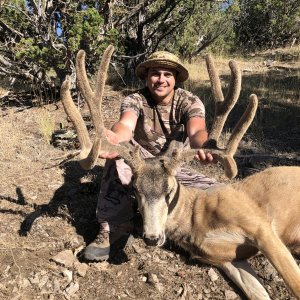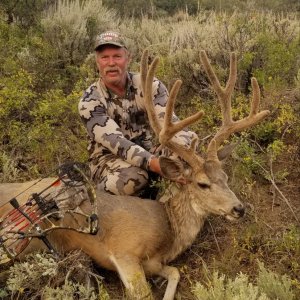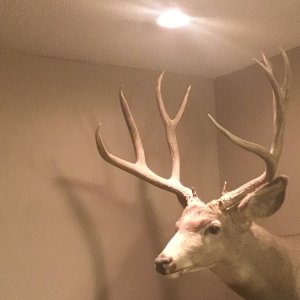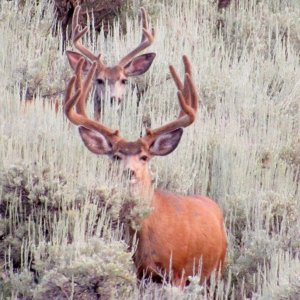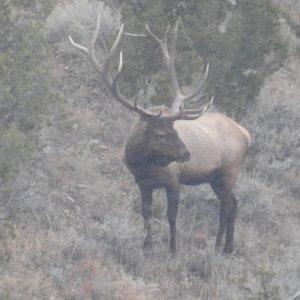alwayzbhuntin
Moderator
- Messages
- 909
One of the nation?s most significant and contiguous desert bighorn sheep habitat is located in the Black Mountains between Kingman, Arizona and Las Vegas, Nevada. This mountain range supports a significant bighorn sheep population that serves as one of the last remaining source populations for transplant efforts in Arizona and other western states in re-establishing new populations into historic habitats. The habitat within the Black Mountains is being jeopardized because the Bureau of Land Management is proposing continued and expanded livestock grazing in this area without current rangeland evaluations. Instead, the BLM is relying on outdated information to justify expanding livestock grazing into bighorn sheep habitat despite repeated objections by the Arizona Game and Fish Commission.
After 25 years since the last rangeland data analysis was completed (1982 Allotment Management Plan), livestock grazing on the Big Ranch ?A? Allotment was reinitiated in 2003 on the heels of Arizona?s worst recorded drought during which three separate wildland fires occurred. Year-round livestock grazing has continued since that time, despite documented bighorn sheep declines and repeated objections from the Arizona Game and Fish Commission.
The Big Ranch ?A? includes a 54,000-acre pasture that is extremely arid and lies below 3,000 feet in elevation. This area receives an average of only 6 to 8 inches of annual rainfall so available forage, as one may assume, is very limited. The year?s available forage must be shared between livestock, wild burros, bighorn sheep and other wildlife species, while maintaining enough residual plant material to support next year?s growing cycle.
Since expiration of the 10-year public land grazing permit in 2001, the BLM has relied on the 2001 DEPARTMENT OF THE INTERIOR AND RELATED AGENCIES APPROPRIATIONS ACT to renew this permit on an annual basis while NEPA and rangeland analysis is being completed. This 2001Congressional rider allows BLM and other federal agencies to delay required NEPA analysis during that current year until the federal agency makes time to complete the analysis. The reality is that the BLM seems to never have time to complete the analysis and they simply reinstate the grazing permit under the rider each year without regard for habitat conditions. Meanwhile, livestock grazing and the drought continue. In September 2003, the BLM completed an environmental impact analysis related to livestock grazing on the allotment and issued a proposed decision that included expansion of livestock grazing into prime sheep habitat. This decision was based on ocular reconnaissance data that was collected in 1976.
Since BLM failed to address concerns over the expansion of livestock grazing into sheep habitat, the Arizona Game and Fish Commission was forced to file an administrative protest in November 2003. The protest was based on the concerns that the evaluation did not adequately describe the newly proposed grazing system nor provide rationale for abandoning established systems. Three and a half years have past since the Arizona Game and Fish Department filed the protest. After numerous meetings between agency personnel, discussions between the respective agency directors, and commitments made to the Arizona Game and Fish Commission, no progress has been made on this issue.
Inappropriate numbers of livestock coupled with drought, recent wildfire activity, highway expansion and human development continue to pose significant problems for the Arizona Game and Fish Commission in managing the area?s bighorn sheep. Survey results for desert bighorn sheep, which is an animal well adapted to arid environments, were 30-percent of normal since grazing was initiated. As a result, the Arizona Game and Fish Commission has undertaken numerous activities to prevent further declines.
Arizona Game and Fish Department biologists have employed population and disease monitoring protocols, and conducted controversial predator management actions in an attempt at arresting alarming population-level declines in this important bighorn sheep herd. Department biologists estimate desert sheep numbers have been experiencing significant declines since the mid 1990?s. The Arizona Game and Fish Commission made significant comments to the BLM?s recent 10 year evaluation of The Black Mountain Ecosystem Management Plan (August 2006) regarding habitat issues for desert sheep. The Arizona Game and Fish Commission has not received any feedback other than the BLM is analyzing the comments and will meet with agency personnel at some point regarding the plan.
Despite all these concerns, the BLM?s response to this protest remains unresolved and grazing is allowed to continue under the Congressional rider. Even if the BLM does make a decision in the near future, there is no guarantee that it will be in the best interest of wildlife. With that said, the Arizona Game and Fish Commission is forced to seek other remedies. Filing an appeal on a BLM decision only sends the matter to the Interior Board of Land Appeals, which is averaging better than five years before rendering decisions. Meanwhile, livestock grazing continues with no resolution in sight.
The Arizona Game and Fish Commission will be considering what further options are available to resolve this continuing impasse.
After 25 years since the last rangeland data analysis was completed (1982 Allotment Management Plan), livestock grazing on the Big Ranch ?A? Allotment was reinitiated in 2003 on the heels of Arizona?s worst recorded drought during which three separate wildland fires occurred. Year-round livestock grazing has continued since that time, despite documented bighorn sheep declines and repeated objections from the Arizona Game and Fish Commission.
The Big Ranch ?A? includes a 54,000-acre pasture that is extremely arid and lies below 3,000 feet in elevation. This area receives an average of only 6 to 8 inches of annual rainfall so available forage, as one may assume, is very limited. The year?s available forage must be shared between livestock, wild burros, bighorn sheep and other wildlife species, while maintaining enough residual plant material to support next year?s growing cycle.
Since expiration of the 10-year public land grazing permit in 2001, the BLM has relied on the 2001 DEPARTMENT OF THE INTERIOR AND RELATED AGENCIES APPROPRIATIONS ACT to renew this permit on an annual basis while NEPA and rangeland analysis is being completed. This 2001Congressional rider allows BLM and other federal agencies to delay required NEPA analysis during that current year until the federal agency makes time to complete the analysis. The reality is that the BLM seems to never have time to complete the analysis and they simply reinstate the grazing permit under the rider each year without regard for habitat conditions. Meanwhile, livestock grazing and the drought continue. In September 2003, the BLM completed an environmental impact analysis related to livestock grazing on the allotment and issued a proposed decision that included expansion of livestock grazing into prime sheep habitat. This decision was based on ocular reconnaissance data that was collected in 1976.
Since BLM failed to address concerns over the expansion of livestock grazing into sheep habitat, the Arizona Game and Fish Commission was forced to file an administrative protest in November 2003. The protest was based on the concerns that the evaluation did not adequately describe the newly proposed grazing system nor provide rationale for abandoning established systems. Three and a half years have past since the Arizona Game and Fish Department filed the protest. After numerous meetings between agency personnel, discussions between the respective agency directors, and commitments made to the Arizona Game and Fish Commission, no progress has been made on this issue.
Inappropriate numbers of livestock coupled with drought, recent wildfire activity, highway expansion and human development continue to pose significant problems for the Arizona Game and Fish Commission in managing the area?s bighorn sheep. Survey results for desert bighorn sheep, which is an animal well adapted to arid environments, were 30-percent of normal since grazing was initiated. As a result, the Arizona Game and Fish Commission has undertaken numerous activities to prevent further declines.
Arizona Game and Fish Department biologists have employed population and disease monitoring protocols, and conducted controversial predator management actions in an attempt at arresting alarming population-level declines in this important bighorn sheep herd. Department biologists estimate desert sheep numbers have been experiencing significant declines since the mid 1990?s. The Arizona Game and Fish Commission made significant comments to the BLM?s recent 10 year evaluation of The Black Mountain Ecosystem Management Plan (August 2006) regarding habitat issues for desert sheep. The Arizona Game and Fish Commission has not received any feedback other than the BLM is analyzing the comments and will meet with agency personnel at some point regarding the plan.
Despite all these concerns, the BLM?s response to this protest remains unresolved and grazing is allowed to continue under the Congressional rider. Even if the BLM does make a decision in the near future, there is no guarantee that it will be in the best interest of wildlife. With that said, the Arizona Game and Fish Commission is forced to seek other remedies. Filing an appeal on a BLM decision only sends the matter to the Interior Board of Land Appeals, which is averaging better than five years before rendering decisions. Meanwhile, livestock grazing continues with no resolution in sight.
The Arizona Game and Fish Commission will be considering what further options are available to resolve this continuing impasse.



